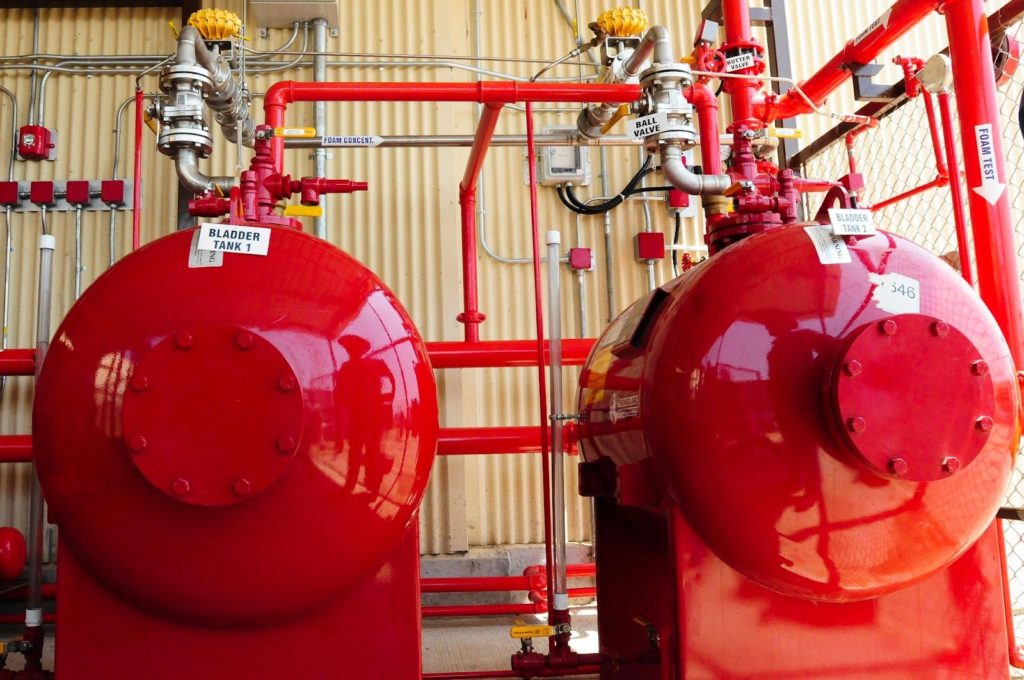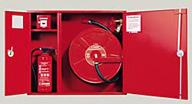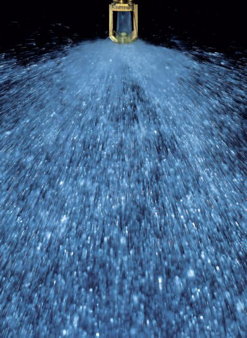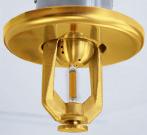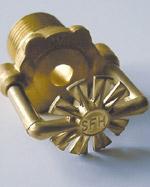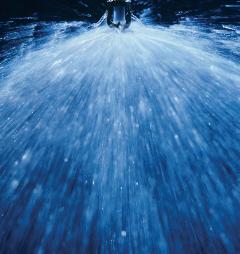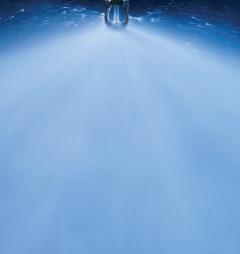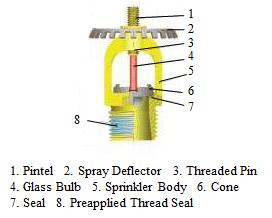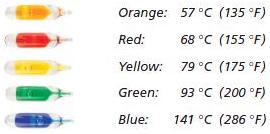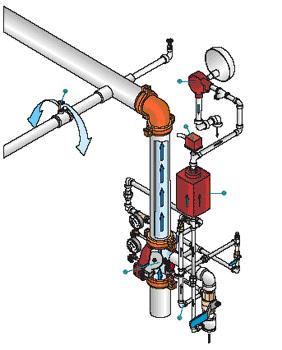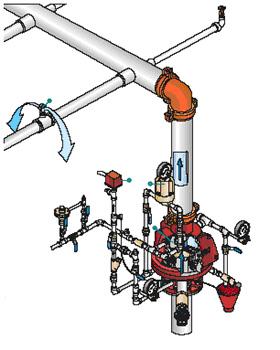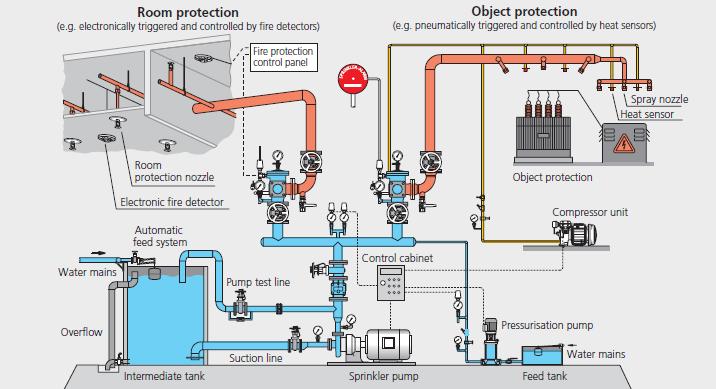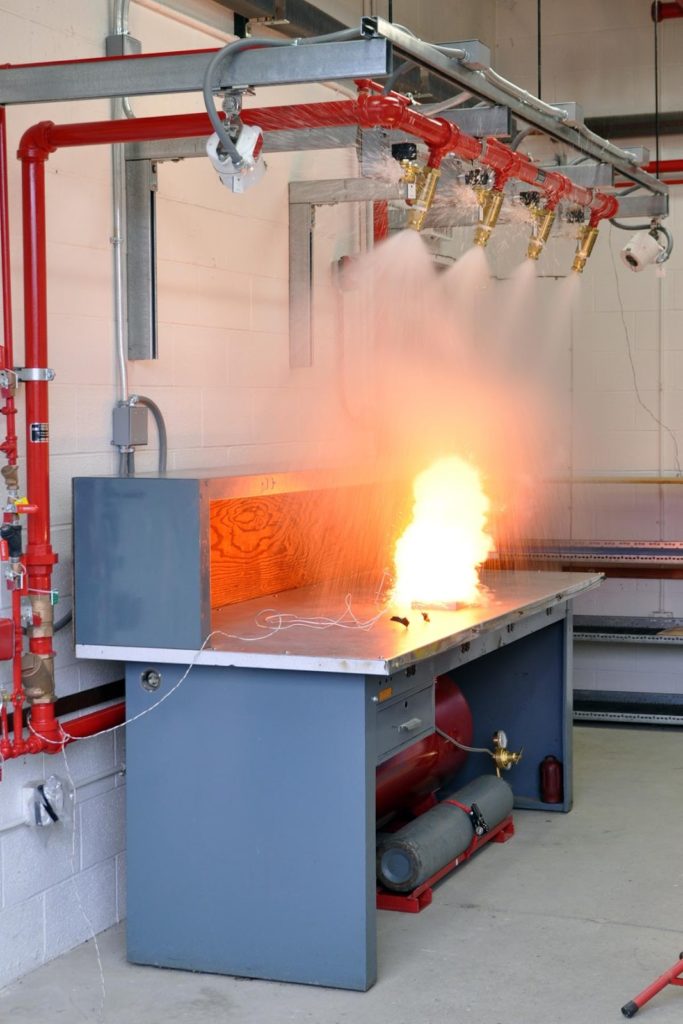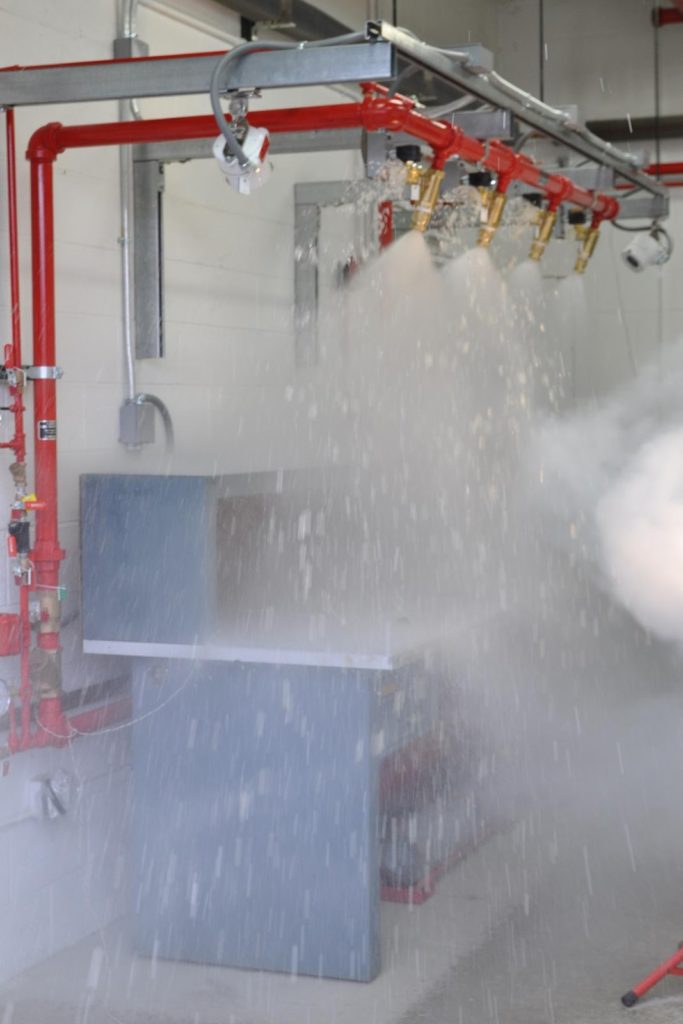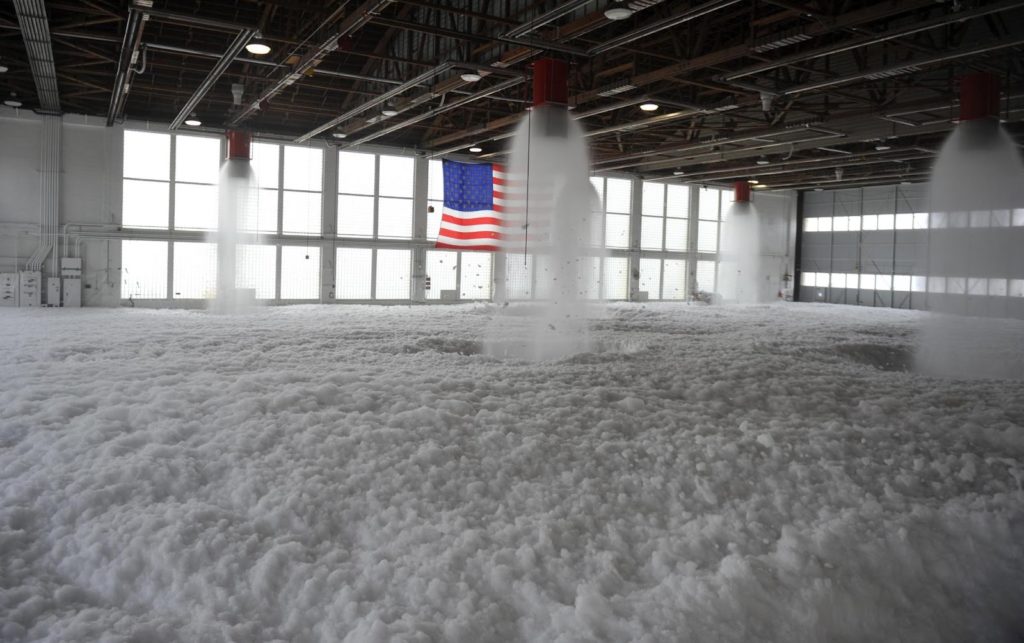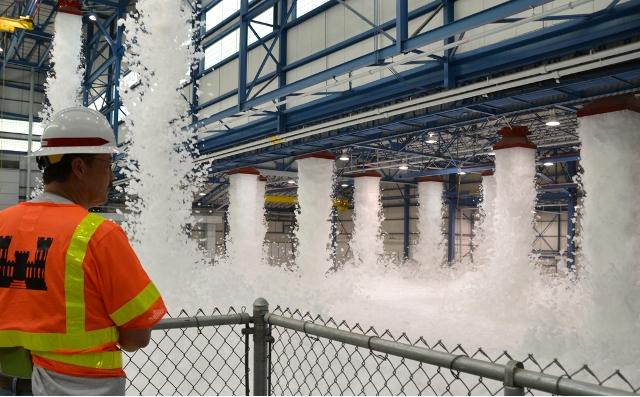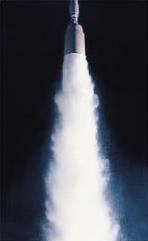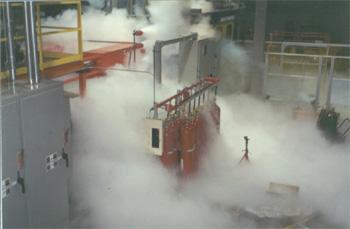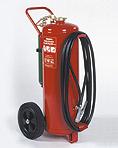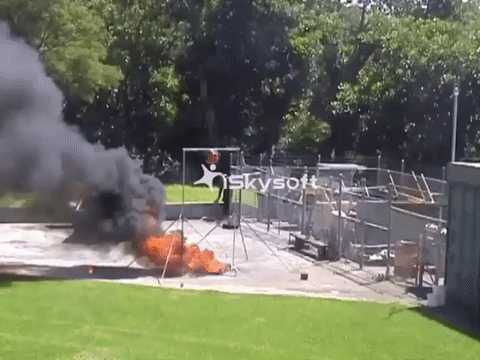Deluge systems provide protection against fires. They are composed of open sprinklers attached to a piping system that is connected to a water supply through a heat-responsive valve. When this valve opens, water is discharged into the piping system and through the open sprinklers. This discharge must occur rapidly and efficiently in response to a fire. Deluge systems can also release other extinguishing materials water, such as foam, dry powder chemicals, or inert gases. The picture below shows the storage tank for a foam deluge system.
Water
Water deluge systems comprise the majority of fire extinguishing and simple sprinkler systems.
General Information
Water is the most naturally abundant and widely used extinguishing substance. It extinguishes fire by cooling.
There are three main types of water deluge systems, components of which are shown below. From left to right, they are fine water spray systems, sprinkler systems, and water spray systems.
(Copyright Minimax GmbH & Co. KG, Bad Oldesloe, Germany )
Equipment Design
Fine Water Spray
Fine water spray deluge systems generate a directional mist of extremely fine water droplets through a nozzle. The nozzle causes the internal atomization of water to deliver a fine spray of specifically sized droplets. Internal atomization of water is the break up of water into small droplets. See the Nozzles section of the encyclopedia for more information.
The pictures below compare a fine water sprinkler (right) to a classic sprinkler (left).
(Copyright Minimax GmbH & Co. KG, Bad Oldesloe, Germany)
This process increases the heat binding capability so the cooling effect, which is even stronger because of water mist evaporation, is intensified. The water vapor also causes a suffocation effect, displacing the oxygen from the fire source. Heat binding is the ability of a substance to absorb heat while in contact with an exothermic substance, such as a fire.
The fine water spray can rapidly and efficiently extinguish fires, even those involving highly volatile hydrocarbons, with only a minute amount of water compared to conventional deluge systems.
Sprinklers
Sprinkler systems are automatic fire extinguishing systems with an easy and safe operating principle: A network of pipes and sprinklers under pressure runs through the site to be protected. A glass bulb within the sprinkler is filled with a heat-sensitive liquid that expands when the ambient temperature rises above a set level, bursting the bulb and allowing the compressed water to disperse. The temperature required for the bulb to shatter depends on the liquid within the bulb. The graphic below shows typical temperature limits for certain bulbs.
(Copyright Minimax GmbH & Co. KG, Bad Oldesloe, Germany)
There are two types of sprinkler systems; wet and dry. Wet systems, which are completely filled with compressed water, are the most common. If the sprinkler bulbs burst water flows out immediately until the supply is stopped again. Dry systems are specially designed for areas with frost danger. In these areas, the sprinkler pipework is filled with compressed air to prevent the possibility of frozen pipes. The water is stored separately until a release in pressure opens a dry pipe valve, allowing the water to flow through the sprinkler system.
Water Spray
Water spray systems provide maximum safety against fast-spreading fires. A water spray system, such as the one in the schematic, is a fixed pipe array designed to deliver water through a valve straight onto special risk areas, such as power plant generation equipment or flammable liquids. These systems operate with open extinguishing nozzles that spread the extinguishing water in the whole protection area while keeping the extinguishant demand low. The water, projected at high velocity, emulsifies the surface of the burning fuel, extinguishing both by cooling and by providing a vapor barrier. Spraying increases the extinguishing water surface, binds the combustion heat, and thus, cools the burning material.
Unlike the other water deluge systems, water spray deluge systems require a water storage tank and pumps in order to provide sufficient water flow and pressure. System operation can be initiated either manually or automatically by hydraulic, pneumatic, or electrical detection systems.
Usage Examples
Water deluge systems are used in many situations.
Fine water spray systems are more suited for small fires and are used for residential and small industrial purposes.
Sprinkler deluge systems are used in many common applications such as storage areas, salesrooms, shopping centers, hospitals, schools, etc.
Water spray deluge systems, due to their large coverage area, are mainly used in large industrial applications such as transformers, wood processing, conveying systems, oil refineries, gasoline dumps, aircraft hangars, and theatres. Shown below are before and after pictures of a High-Speed Deluge System mounted above a munitions processing work table. The system shown is designed to react to a heat source within one-tenth of a second and spray close to three hundred gallons of water to extinguish the fire.
(Copyright US Air Force Reserve Command)
Advantages
- Less expensive than other methods
- Uses water, the most abundant extinguishant in the world
Disadvantages
- Damage occurs if used on sensitive and/or electronic equipment
- Clean-up is more time consuming than for gas and powder systems
- Must have a large water reservoir to operate
Foam
Extinguishing foam is a highly effective extinguishant consisting of water, foaming agent, and air.
General Information
Stable foaming agents and air are mixed with flowing water to create extinguishing foam. The fraction of air in the mixture determines its foam density. The higher the air content, the lower the foam density. Different deluge systems require different foam densities. For example, the low-density foam shown here would descend from a valve above.
Extinguishing foam puts out fires through various means: cooling, suffocating, separating, covering, restraining, and displacing. Both individual and combinations of foaming agents provide effective fire suppression.
Foam extinguishing systems are used for classification A and B fires of solid and liquid substances, and to a limited extent for type C fires of gaseous substances.
Type A: Paper, wood, cloth, etc… fire, for which extinguishing with water or blanketing with foam is effective.
Type B: Flammable liquid fire, for which smothering is required.
Type C: Live electrical equipment fire, for which non-conductivity of the extinguishant is vital.
Equipment Design
Firefighting foaming agents suppress fire by separating the fuel from the air (oxygen) and cooling the fire by the water content of the foam. The foam blanket suppresses the release of flammable vapors that can mix with air.
Low expansion foam nozzles are used to disperse the foam. These nozzles are specially designed for type A and B fires. Foam guns are also used for fighting fires from a safe distance and for the preventative cooling of objects in danger of fire. They are aimed manually, electrically, or hydraulically at the corresponding target. They can be equipped with a foam/water jet pipe as well as multipurpose nozzles to alternate between foam and water.
Usage Examples
Foam extinguishing systems are used for hazardous materials, chemical industry, oil refineries, and laboratories.
Aqueous Film-Forming Foams (AFFF) are used by fire departments, as well as in airports, refineries, manufacturing plants, and any other operation involving the handling of flammable liquids and materials. Shown below is a high expansion foam (HEF) being tested at an air hangar base. The HEF expands to fill large areas and suffocate fires.
Alcohol-Resistant Concentrate foams are based on AFFF concentrates with an added polymer to make them effective on fires involving polar solvents (methanol) as well as hydrocarbon-based fuels (gasoline).
Advantages
- Versatile and effective for the proper extinguishing of hazardous fires.
- Can be proportionated to extinguish many types of fires
- Very fluid, easily flows over liquid surfaces
Disadvantages
- Can be up to four times more costly than water systems
- Clean-up requires much more time than other extinguishing systems
Gas
General Information/Equipment Design
Gas deluge systems are clean and effective, non-damaging to surfaces, easy to clean up, and recognized and approved worldwide.
Gas systems have varied uses and extinguish with the inert gases argon (Ar), nitrogen (N 2 ), or carbon dioxide (CO 2 ). Argon is a non-poisonous noble gas, which does not show a cooling effect during flooding. Nitrogen is a non-poisonous, non-cooling gas that has minimal uses but is efficient. Carbon dioxide is often used because it produces a thick aerosol cloud in the flooding area, which can be precisely adjusted via the nozzles.
Usage Examples
Gas systems are generally used for chemical works, oil dumps, compressor and pump stations, laboratory rooms and equipment, and hazardous waste systems.
Gas systems are very useful for applications in which wet extinguishants cannot be used and where clean-up cannot be maintained. The cost of this method is a major drawback, however.
Powder
General Information
The extinguishing powders used in powder extinguishing systems are highly efficient, quick-acting extinguishers. The sudden extinguishing effect of the powder cloud is caused by a suffocation effect and an anti-catalytic effect, a chemical intervention into the combustion process.
Usage Examples
Some uses for powder deluge systems are in the storing of hazardous materials, oil chemistry and refineries, airports, laboratories, and large garages. Powder deluge systems are specifically suited for use around very sensitive material where wet substances can damage the products. A disadvantage of these systems is that they are costly and difficult to clean up.
Acknowledgments
- Fire Systems, Inc., Smyrna, GA
- Fire Supression Inc, Bad Oldesloe, Germany; now part of Minimax GmbH & Co. KG
- Minimax GmbH & Co. KG, Bad Oldesloe, Germany
- US Air Force Civil Engineering Center
- US Air Forces in Europe, Air Force Africa
- US Air Force Reserve Command
- US Army Corps of Engineers North Atlantic Division
References
- Daniel A. Crowl and Joseph F. Louvar. Chemical Process Safety: Fundamentals with Applications. New Jersey: Prentice-Hall, 1990. Print.
Developers
- Anil Joy
- Sneha Shah
- Kelsey Kaplan
- Keith Minbiole

